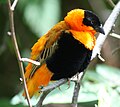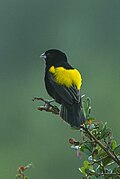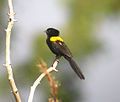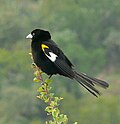| Image | Scientific name | Common name | Distribution |
|---|
 | Euplectes afer | Yellow-crowned bishop | sparsely distributed across Sub-Saharan Africa |
| Euplectes diadematus | Fire-fronted bishop | Kenya, Somalia, and Tanzania |
 | Euplectes aureus | Golden-backed bishop | western Angola and São Tomé Island |
 | Euplectes gierowii | Black bishop | Angola, Cameroon, Central African Republic, Republic of the Congo, Democratic Republic of the Congo, Ethiopia, Kenya, South Sudan, Tanzania, and Uganda |
 | Euplectes nigroventris | Zanzibar red bishop | Kenya, Mozambique, and Tanzania |
 | Euplectes hordeaceus | Black-winged red bishop | Senegal to Sudan and south to Angola, Tanzania, Zimbabwe and Mozambique |
 | Euplectes orix | Southern red bishop or red bishop, | north to Angola, southern and eastern parts of the Democratic Republic of Congo,northern Zambia southern Uganda north-east Nigeria and south-west Kenya |
 | Euplectes franciscanus | Northern red bishop or orange bishop, | Africa south of the Sahara Desert and north of the Equator |
 | Euplectes capensis | Yellow bishop | Afromontane |
 | Euplectes axillaris | Fan-tailed widowbird | Angola, Botswana, Burundi, Cameroon, Central African Republic, Chad, Republic of the Congo, DRC, Eswatini, Ethiopia, Kenya, Lesotho, Malawi, Mali, Mozambique, Namibia, Niger, Nigeria, Rwanda, Somalia, South Africa, Sudan, Tanzania, Uganda, Zambia, and Zimbabwe |
 | Euplectes macroura | Yellow-mantled widowbird | Angola, Benin, Burkina Faso, Burundi, Cameroon, Central African Republic, Chad, Republic of the Congo, Democratic Republic of the Congo, Ivory Coast, Gabon, Gambia, Ghana, Guinea, Guinea-Bissau, Liberia, Malawi, Mali, Mozambique, Niger, Nigeria, Senegal, Sierra Leone, Sudan, Tanzania, Togo, Zambia and Zimbabwe. |
 | Euplectes hartlaubi | Marsh widowbird | Angola, Cameroon, Republic of the Congo, Democratic Republic of the Congo, Gabon, Kenya, Nigeria, Tanzania, Uganda, and Zambia. |
 | Euplectes psammacromius | Montane widowbird | northeast Zambia, northern Malawi and the highlands of southwestern Tanzania |
 | Euplectes albonotatus | White-winged widowbird | Angola, Botswana, Burundi, Central African Republic, the Republic of the Congo, the Democratic Republic of the Congo, Eswatini, Ethiopia, Gabon, Kenya, Malawi, Mozambique, Namibia, Rwanda, São Tomé, South Africa, Sudan, Tanzania, Uganda, Zambia, and Zimbabwe |
 | Euplectes ardens | Red-collared widowbird | Guinea, inland Sierra Leone, north Liberia, north Ivory Coast, southwest Niger, central and southeast Nigeria, Cameroon, Central African Republic, Democratic Republic of Congo, central and northeast Angola, Uganda, West Kenya, Tanzania, Malawi, northwest and south Mozambique, Eswatini and east South Africa |
 | Euplectes laticauda | Red-cowled widowbird | Sudan, Eritrea, Ethiopia, Kenya and north Tanzania |
 | Euplectes progne | Long-tailed widowbird | Angola, Botswana, the Democratic Republic of the Congo, Eswatini, Kenya, Lesotho, South Africa, and Zambia |
 | Euplectes jacksoni | Jackson's widowbird | Kenya and Tanzania |
|

















